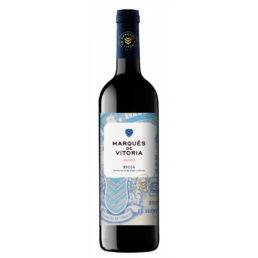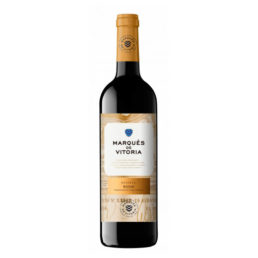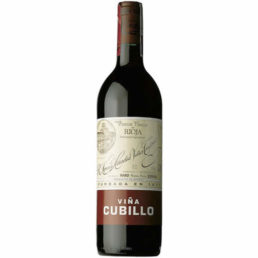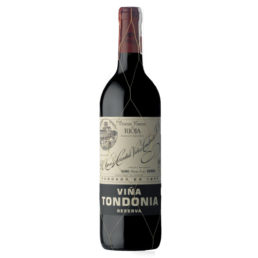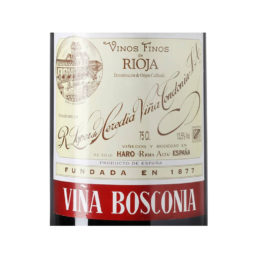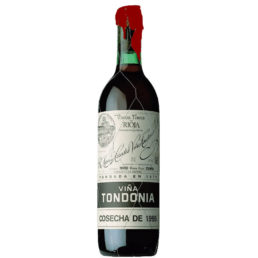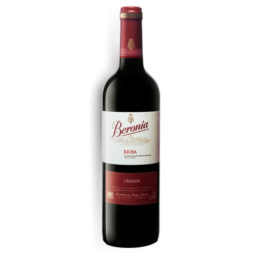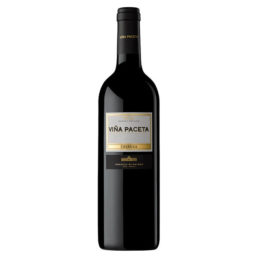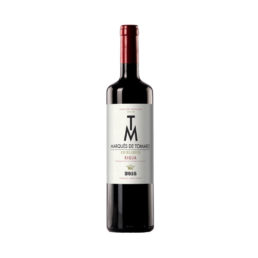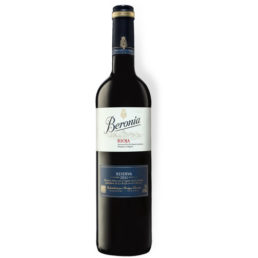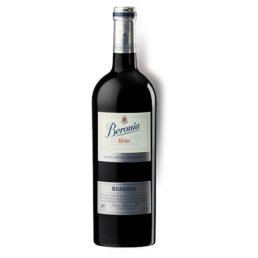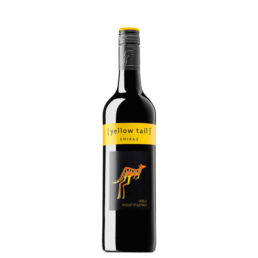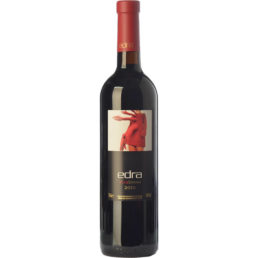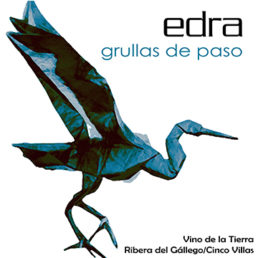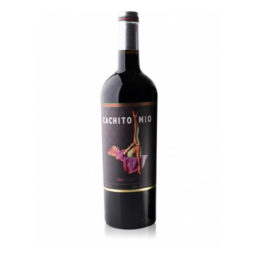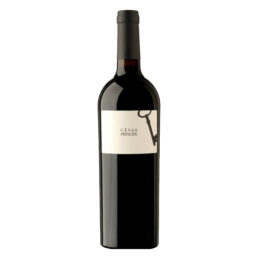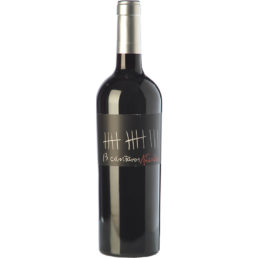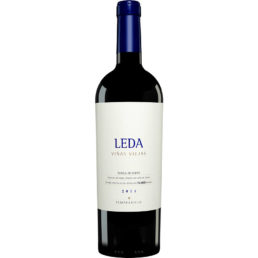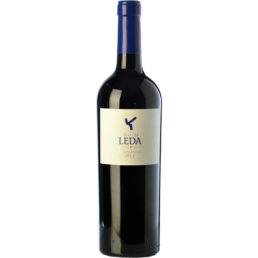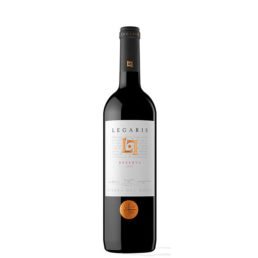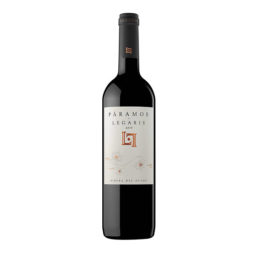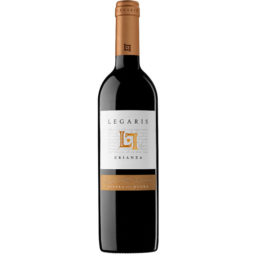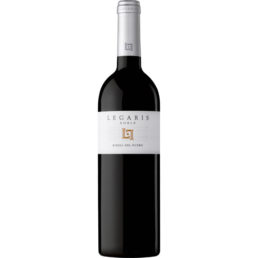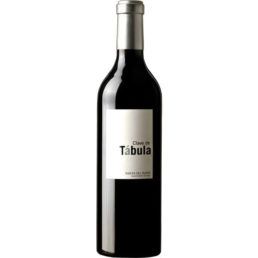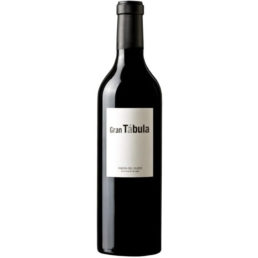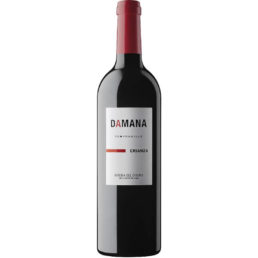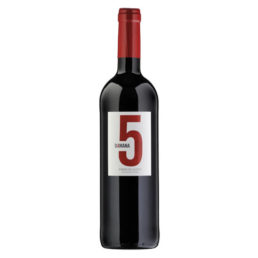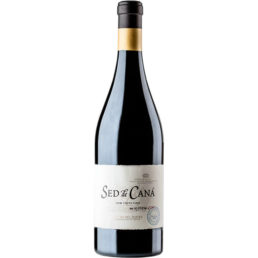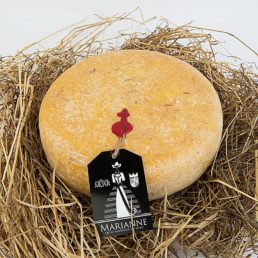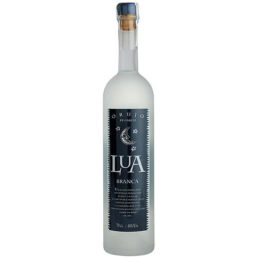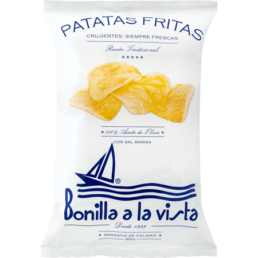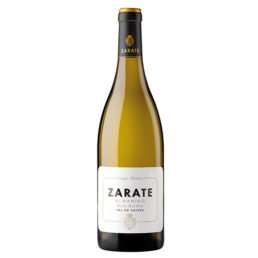Red Wine
-
Marqués de Vitoria Crianza 2014
Production/winemakingThe grape is harvested, selected, destemmed and fermented at controlled temperature in order to subsequently raise during 12 months in american oak barrels. Fine-tuned end in the bottle in the interior of the cellars.PairingIt is easy to pair with any type of meat. Grilled mushrooms. Some fish a lot of flavor or fatty, like tuna or cod. Cheese emmental or gruyere. Good with rice with mushrooms. -
Marqués de Vitoria Crianza 2015 (Magnum)
Production/winemakingThe grape is harvested, selected, destemmed and fermented at controlled temperature in order to subsequently raise during 12 months in american oak barrels. Fine-tuned end in the bottle in the interior of the cellars.PairingIt is easy to pair with any type of meat. Grilled mushrooms. Some fish a lot of flavor or fatty, like tuna or cod. Cheese emmental or gruyere. Good with rice with mushrooms. -
Marqués de Vitoria Reserve 2011
From of strains between 25 and 30 years of age. Remains 24 months in new French oak barrels followed by an ageing in bottle before release onto the market.PairingIt is easy to pair with any kind of meat and grilled mushrooms. Some fish a lot of flavor or fatty, like tuna or cod. Cheeses of medium healing; emmental and gruyere. Pasta with tomato and/or cheese.AwardsGolden Bacchus, Awards Bacchus 2016 (Spain)Gold Medal, World of Wine 2016 (Germany) -
Viña Cubillo Crianza 2012
HarvestThe grape harvest began on the day 6 October in "Vineyard Zaconia" with the white grape varieties, the day 9 October in "The Viña Tondonia Estate" with red varieties and finalized the 30 October after harvest "Viña Cubillas" and "Viña Bosconia".AgingAging in barrels during 3 years, subject to 2 fillings per year.BottledClarified with egg whites. Bottled unfiltered.Production93.000 bottlesPairingIt is the perfect companion for all kinds of legumes, tapas and hors d'oeuvres varied. -
The Viña Tondonia Estate Reserve 2002
Viña Tondonia Reserva wine 2002 Red 75 Cl. RiojaThe Tondonia Tinto is a fine wine, elegant with spicy and vanilla notes from barrel aging, without realizing it the whole bottle runs out, very easy to drink, accompanies both warm salads with quail or bird, puff pastry, foie gras with a reduction of raspberry jam, as to roast lamb, or suckling pig. In general, with almost everything, it is a wine that is very versatile. -
The Viña Tondonia Estate Reserve 2005 (Magnum)
Characteristics of the harvest: Year rated as EXCELLENT. Of the 170 has. in the property of our warehouse, distributed in our 4 farms, in this year 2005 we had 154 has in production. The harvest of 2005 was significantly lower than that of 2004, mainly because the sample of inflorescences in the bud break was a bit lower. The vegetative cycle occurred properly, in good weather conditions with absence of frost, and accidents meteorological remarkable, and only it should be noted that the advancement, about ten days, with the onset of the sprouting continued until the harvest which began the day 24 September in “Viña Gravonia” with the white varieties, the day 27 the same month, in “Viña tondonia estate” for the varieties and ended the day 22 October in “Viña Cubillas”. A strong storm surprised us on the day 12 October and produced this delay with respect to what might determine a start so early. In addition to this delay, so intense rainfall –more than 40 l/m2 in less than an hour– caused damage more important on the ground (drag land, fall of ribazos, flooding of farms and cellars...) in the bunches that were left for harvest, approximately a 20% of the final production, which we could qualify as a very good quality. The grapes came in healthy, with an average grade balanced and good concentration of colouring matter, essential characteristics to create wines with vocation for ageing.Aging in barrel: 6 years old, subject to 2 rackings per year. Clarified with whites of fresh eggs.Production: 250.000 bottles.Pairing: With notes of spices and vanilla from the barrel aging, without realizing the whole bottle just, very easy to drink, accompanies both warm salads with quail or bird, puff pastry, foie gras with a reduction of raspberry jam, as to roast lamb, or suckling pig. In general, with almost everything, it is a wine that is very versatile. -
Red wine – Viña Bosconia Reserva 2009
Add characterized by the absence of spring frosts, and the good environmental conditions that were conducive to the fertilization and the ripening of the grapes. All of this resulted in an abundant harvest despite suffering a summer unsettled and stormy that was balanced with the optimal climatic conditions of a month of October, bright and fresh. The harvest took place step-by-step with the perfect sanitary state of the grapes.AgingIs subjected to aging in oak barrels 5 years old, with 2 rackings per year.BottledClarified with whites of fresh eggs. Bottled unfiltered.PairingCured meats, legumes and stews, red meats and fighters, but also just a wonderful meal with cheese or chocolate desserts and wild black fruit. -
The Viña Tondonia Estate Gran Reserva 2001 Red
Aging in oak barrels: 10 years old, with 2 rackings per year, hand-made. Clarified with whites of fresh eggs.Pairing Meats and fish grilled, without strong spices. Also as a dessert wine accompanied by tubes filled with a fine pastry cream. -
Red wine Beronia Crianza 25 cl.
VINIFICATION AND AGEING After a slow Alcoholic fermentation, performs malolactic fermentation, and remains 12 months deposits. Subsequently this wine was transferred to barrels mixed: staves of american oak and funds of French oak, where it remains a minimum of 12 months. This is followed by a time in bottle before release onto the market.PAIRING It is the ideal companion for pasta dishes, vegetables and meats. -
Red wine Beronia – Beronia 3/8 Foster 2015
VINIFICATION AND AGEING After a slow Alcoholic fermentation, performs malolactic fermentation, and remains 12 months deposits. Subsequently this wine was transferred to barrels mixed: staves of american oak and funds of French oak, where it remains a minimum of 12 months. This is followed by a time in bottle before release onto the market.PAIRING It is the ideal companion for pasta dishes, vegetables and meats. -
Red wine Beronia Crianza
VINIFICATION AND AGEING After a slow Alcoholic fermentation, performs malolactic fermentation, and remains 12 months deposits. Subsequently this wine was transferred to barrels mixed: staves of american oak and funds of French oak, where it remains a minimum of 12 months. This is followed by a time in bottle before release onto the market.PAIRING It is ideal to accompany roasts, chops grilled, sausage iberian, or cured cheeses. -
Red wine Beronia – Beronia Crianza 2014 (Magnum)
VINIFICATION AND AGEING After a slow Alcoholic fermentation, performs malolactic fermentation, and remains 12 months deposits. Subsequently this wine was transferred to barrels mixed: staves of american oak and funds of French oak, where it remains a minimum of 12 months. This is followed by a time in bottle before release onto the market.PAIRING It is ideal to accompany roasts, chops grilled, sausage iberian, or cured cheeses. -
Red wine – Viña Paceta
Viña Paceta it is a red wine crianza from the O.D.. Rioja prepared by Bodegas Bilbaínas. It is a single variety of Tempranillo, grape par excellence of the region Rioja.The grapes to form Viña Paceta it comes from an iconic estate nestled in Halo, municipality known for the high density of wineries that you have and the quality of the same.Viña Paceta is formed from the de-stemming of the grapes, that makes a maceration of fifteen days subsequently. The wine ages eventually during 12 months in american oak barrels. -
Red wine Marqués de Tomares Excellence
Collection: Manual harvest with baskets.Elaboration: 55% carbonic maceration and 45% grapes destemmed. Maceration for 19 days with 3 stirred daily.Foster: 3 months in new barrel of american oak and 9 months in bottle.Recommended: It combines perfectly with cheeses, meats soft and blue fish. -
Red wine Beronia Reserva 2013
VINIFICATION AND AGEING This wine is made from a selection of the best grapes from vineyards older Tempranillo, Graciano and Mazuelo. After a slow and careful controlled fermentation with pumping over newspapers to extract the color and aromas are desired, this wine remained for 20 months in barrels mixed French and american oak, getting an evolution slow and harmonic. Later, he completed his parenting during 16 months in bottle before going to market.PAIRING Perfect to accompany with roasted, chops grilled, Spanish sausage iberico, or cured cheeses. -
Red wine Marqués de Tomares – Monteleiva Crianz
PairingVeal, lamb, milk-fed veal, poultry. -
Red wine Beronia 198 Barrels 2008 (Reservation)
VINIFICATION AND AGEING Selection of grapes from vineyards with an age of more than 60 years old. This wine is aged in a selection of the best new barrels and mixed, during 24 months. Subsequently complete their rearing for two years in the bottle, achieving their perfect balance.PAIRING This wine pairs perfectly with the cuisine, as the traditional cuisine. -
Vino tinto Beronia Gran Reserva 2009
VINIFICATION AND AGEING After a careful selection and fermentation of the grape, it has been aging for a 27 months in French oak barrels, By racking semester we get an evolution slow and orderly processes of their characters. Remains 36 months in bottle before going to market.PAIRING Ideal accompaniment of red meats, roast beef, cheeses and chocolate desserts. -
Red wine Beronia – III.C. Beronia 2008
DEVELOPMENTIt is part of the selection from vineyards of more than 70 years old, in addition the use of our vineyards prefiloxéricos. Cold pre-fermentation maceration for a few days, alcoholic fermentation below 26 ° C with pumping over newspapers. Ageing in new barrels of French oak during 14 months.AWARDS 91 points 2012 Parker (The Wine Advocate)SERVICE AND FOOD PAIRINGPerfect with red meats such as t-bone steak, steak, fillet steak or mature cheeses of sheep. -
Vino Tinto Yellow Tail Syrah – Australia
The philosophy behind the brand Yellow Tail is to offer wines that are simple and aimed at anyone who wants to enjoy a glass of wine with friends without major complications. Shiraz is the variety most widespread in Australia, so this wine red wine is the maximum expression of Yellow Tail. Yellow Tail Shiraz is a wine that is intense without being excessive, very easy to drink even as young wine.DEVELOPMENT (VINIFICATION) The Shiraz from Yellow Tail is made from grapes from vineyards of the highest quality. Once pressed and being removed from their stems, the grapes are fermented with the skins and in contact with oak wood. Its temperature-controlled fermentation ensures extraction of all the flavor, the color and tannins typical of the variety. The wine is bottled in the cellars of the family Casella, in Yenda, New South Wales.PAIRINGAccompanying Yellow Tail Shiraz with a good steak or a bbq. -
We drink red wine 2015
Awards89 Points Guide AkataVino WineXtreme ed. 2017 -
Red wine Edra Xtra Syrah
Edra XtraSyrah 2014, variety of balanced year after year, with a freshness and ripe fruit as a response to the summer balanced 2014; powerful, with personality and smoothness at the same time. It offers intense and deep aromas of menthol because of the variety and toasted, roasted and chocolateblack, due to the terroir and the sunny Hoya de Huesca in the foothills of the pyrenees. Silky and with a long and honest aftertaste. The rest in French oak and a little american,with batonagge with their own lies, given the maturity and golosidad necessary.Vintage grape own, selection of plot, vintage manual 8 September.Fermentation maceration in cold chamber, delestage open and closed.Malolactic barrel French.Aging ”batonnage” with the addition of the lees 12 months in French oak selection andAmerican.Label the work of the artist Mª Pi Rivera -
Red wine Grullas Paso
In the municipality of La Hoya (Huesca),small winery Bodegas Edra made with IGP Ribera del Gallego - Cinco Villas, the wine Edra Grullas Paso, a red wine oak own vineyards located in the Pre-Pyrenees of Aragon.The blend is still a selection of Merlot, Cabernet Sauvignon, Tempranillo and Garnacha.Activities in the vineyard always develop in a respectful way with the environment, doing all the work manually without using chemicals or aggressive elements. The vineyards are surrounded by fields of legumes and alfalfa.Selected grapes are separately vinifica fermentations in stainless steel at a controlled temperature and delestages newspapers to extract maximum pigmentation and phenolic components of the skins. Red wine Edra Grullas Paso 2016 Ribera del Gallego makes raising 4 months in barrels of French and American oak which are made "batonnage" with addition of lees. the blend is made and bottled.The name of this wine, Step cranes, He wants to remember the presence in the vineyards of these migratory birds when they take a short break before resuming forces on their journey from north to south. -
Red wine Vineyards of Aromaz – Aromaz
Aromaz it is one of the last projects of the family Osborne-Osborne. Born in the heart of Castilla La Mancha, in the finca La Cañada, one of the most beautiful of the region.The grapes for the Aromaz come from a single payment called The Captain, the vineyard of the highest estate, with strains in the glass of more than 40 years resting on limestone based soils and stony. There the yields are very small and the quality very high, as certifies every sip of Aromaz.It is a red, fruity-packed with typicity and character. Of cover layer and cherry color, the spices and berries are dealt the role in a nose to be seductive. In the mouth it is kind and noble, of elegant touch and a good fruity. Juicy, balanced and long finish. -
Red wine Casa Maguila – Perhaps
The Casa Maguila It has the habit of baptizing their wines with names boleros. This is particularly inspired by the famous song by Cuban artist Osvaldo Farrés "Perhaps, maybe, maybe". We have a wine balsamic on the nose and mouth, with aromas of ripe fruit and a balanced taste, tasty and long.WinemakingMechanical destemming and grape selection on vibrating belt. It encuba dry ice lowering the temperature to 6 ° C and allowed to start fermentation spontaneously. Malolactic fermentation in barrel.AgingParenting 20 months in French oak barrels, of which 80% They were new and the rest used.Limited productionPairing1.812 bottlesWhite meat, red meat, traditional cuisine and Mediterranean cuisine. -
Red wine Casa Maguila – Cachito Mío
Cachito mío is the name of a well-known bolero, is presented to the public with a striking and bold exterior presentation, it has been conceived as a wine of bold spirit and innovative within the D. O. Toro.Faithful representative of the character of your wine cellar, it is striking for its style, that expresses all the power and fruit of the grape Tinta de Toro, at the same time that it is very pleasant to drink, with an easy and at the same time complex step of mouth. .ElaborationSelection of bunches in the vineyard and in the winery, from old vineyards. Kernels of the harvest, with total elimination of scratches and other foreign elements. Vatting and fermentation with whole grains at a controlled temperature, finishing off with your drained and pressed at low pressure. Moderate stabilization and bottling. -
Red wine Casa Maguila – Angelitos Negros
Angelitos Negros it is a red wine with D. O. Toro, elaborated with grape variety 100% Tinta de Toro (Tempranillo), from vineyards of between 20 and 40 years planted in sandy soils with high percentage of limestone and cultured on glass in the traditional way.The grapes to get the wine Angelitos Negros, are selected at harvest and in the cellar, by performing an exhaustive selection of the grapes, by choosing only the ones which reach their optimum point of ripeness and healthiness. The grapes for the wine Angelitos negros are encubadas and fermented in whole grains. Carbonic maceration a day and a half, pressing and barreling to perform the malolactic fermentation in concrete tanks. Later Angelitos Negros performs an aging process of 6 months in barrels of second year 50% French oak and 50% american oak. -
Red wine Caesar Prince
Caesar Prince the Duke was the father of Ignacio, it seems that outside of the nobility and the really nobility had. I used to say "a long title and low pay". He was a man austere but full of values, deep values that give the roots, the work and the love for his own. He never stopped working, all the days of his life went out into the field, always pending, always in their things.Today we have this wine thanks to his work in the vineyards, to improve and maintain the vineyards, to suffer the vintages, your unconditional support.Caesar Prince is more than a brand, it is our badge and our responsibility. Make the wines your best is not enough, also have to transmit our history, our values, for the enjoyment of all and for the generations to come will get them this lesson, it will be his best legacy.Is the wine most recognized winery and one of the first wines of the Appellation of Origin Cigales in being present in the letters of the most prestigious restaurants.It is made with grapes from vineyards of between 70 and 100 years old, of the plots The Black, The Stop, The Sheepfold and The Sailboat, located on hillside with little slope. Although the vineyards there are other varieties, only be harvested for Caesar Prince the strains of the Tempranillo variety, with very low yields. The soils are composed of clay and sand in-depth, with a lot of pebbles on the surface.After 14 months of ageing in oak barrels, the result is an elegant wine, fine and subtle.Awards93 points guide Peñín -
Red wine Caesar Prince – 13 Nicolas Cántaros
He took out his pocket knife, where he lived since his father gave it as a child, and she recorded "I must 13 Nicolas pitchers' on the mud wall at the entrance of the armhole that belonged to his brother. It was the cellar of his grandparents, they remember.Debt wine was to fill the tino, fleeing oxidation, Common favors between neighbors and relatives because the survival was a matter of all. It seems that the debt is not paid off and today we take also advantage.Was honored not collect it for the many favors exchanged and honor also not delete, that said favors not forget. Also honor and remember what we do here.13 Nicolas Cántaros It is a wine that speaks of our history, the old cellar dug into the rock on the slopes of Fuensaldaña, where Grandpa Eutychius began producing his first wines in bulk. He used the limestone walls of the cellar to bring your own accounting, the 'should' and 'have'. This wine is a tribute to his legacy, to the traditions of Fuensaldaña and Cigales.Comes a selection of Tempranillo vineyards located exclusively in Fuensaldaña and remains 8 months in oak barrels. It is a fruity wine cooler and Prince Caesar, designed to enjoy as you would grandfather, a snack with friends. Those priceless moments that gives the wine. -
Red wine Bodegas Leda – Leda Viñas Viejas
Leda Viñas Viejas it is the wine which embodies the principles of Bodegas Leda. A red wine multiterroir made from grapes from Tempranillo vines 70 and 100 years old, with low yields between 2.000 and 2.500 Kg/Ha, from two of the most emblematic areas of Castile and León: Ribera del Duero and Toro.
Leda Viñas Viejas is the flagship of the winery, with a production that varies depending on the quality of the vintage, between 2.000 and 12.000 bottles.
100% Tempranillo. Leda Viñas Viejas is a wine of guard powerful racial and, with an ageing long 18 to 24 months, depending on the vintage.
PairingMeats white or red, casseroles, soups and stews. -
Red wine Bodegas Leda – Mas de Leda
Most of Leda it is the result of the integration of different payments Tempranillo, from vineyards of more 40 years old, with yields between 4.00 and 4.500 Kg/Ha.
It is a wine Multiterroir, elegant and easy to drink, that seeks to capture the essence of the area from which it comes, mostly Bull, Cigales, Valtiendas and Tudela de Duero.
-
Red wine Legaris – Legaris Reserva
Legaris Reserva wine is the benchmark of the winery and the award-winning. The character of Legaris Reserva is clearly marked both for the vineyard as the mix master of different wines made with the Tempranillo grape variety and aged in different types of barrels.DEVELOPMENT (VINIFICATION)The grapes are harvested manually in boxes of 15 kilos; when you arrive at the winery are stored in a cold room for a night to 6º C, and the next morning, we inspect it thoroughly in the selection table. Once destemmed and transported by belts and, reaches virtually the whole of the small reservoirs, conical stainless steel 5.200 liters, where we separate the different origins of the grapes. We begin with a pre-fermentation maceration of several days at low temperature before alcoholic fermentation, that was done with its indigenous yeasts to 28-30 ºC, to express the characteristics of the different terroirs, respecting the uniqueness of each individual vintage. During the fermentation, made frequent bazuqueos manuals and descuba to the 3 weeks hatch the grape getting only the wine flower, and without later addition of the wine press.Then carried out the malolactic fermentation in new barrels of French oak. Later the wine remains for 20 months in bordeaux barrels of French oak of fine grain, half new and half of a wine, from 10 tonelerías different. After a soft clarification with egg white, was bottled in may 2015. This wine is finished to fine tune during your stay in wine rack for 24 months before you start to be marketed.This harvest consists of 86.037 bottles bordeaux.VINEYARD (VITICULTURE)This wine has been elaborated only with the grape variety Tinto Fino (Tempranillo) 100%. The grapes come from a comprehensive selection of small hawthorns in glass, between the ages of 50 and the 90 years old, from various terms located in the province of Burgos: Peñaranda de Duero, Olmedillo de Roa, Roa and Hontoria Part, of D.O. Ribera del Duero. The average elevation of these vineyards ranges between 850 and the 1.000 meters. These old vines are established on soils with a character very fertile, well type sandy, sandy gravel or clayey-calcareous. The vineyard formerly stood in these "poor soils" not to be used for crops other, only for the vine. Vintage 2012 it went smoothly between the 6 and 17 October. Given the level of maturity of the grapes that we require to be able to produce this exceptional wine, what we can offer 7 in 8 harvests in each decade.PAIRINGLegaris Reserva pairs perfectly with lamb, Spanish, red meat grilled or roasted, game stews and cured cheeses.AWARDS95 POINTS GUÍA GOURMETS 201690 POINTS GUIDE PEÑÍN 2017GOLD MEDAL CINVE - 2016SILVER MEDAL INTERNATIONAL WINE & SPIRIT COMPETITION - 2016 -
Red wine Wastelands of Legaris
Moors of Legaris is an author wine elaborated with the best moors of Ribera del Duero: Moradillo de Roa, Peñafiel and Pesquera del Duero, with a profile of the modern court which seeks the maximum varietal expression. Maturity and balance, with oak presente in flavor and texture.Moors of Legaris reflects the extreme character of the Tempranillo in an extreme zone, the Ribera del Duero.Limited edition of 12.000 bottles.DEVELOPMENT (VINIFICATION)The grape is transferred quickly to the winery to maintain its qualities. After de-stemming, the grape reaches virtually the whole of the deposits of stainless steel, drafted separately the different origins of the grapes.We do a cold pre-fermentation maceration (10 ºC) during 3-4 days in order to extract aromas and colour and then let it gradually increase the temperature. The wines start the alcoholic fermentation and natural way to express the typicality of our different terroirs the made with their own indigenous yeasts.Fermentation temperatures range between 26 and 28 ºC. The devatting or drawing off is performed between 14-16 days from the vatting.In order to respect the fruity character of our Wastelands of Legaris, parenting media in the barrel has been 9 months in bordeaux barrels, selected in a ratio of 2/3 French oak of fine grain and 1/3 american oak, in both cases, with a 30% of new barrels.This wine has not been stabilized by cold, so that for their production of natural might present sediment. To fine-tune the wine was a soft clarification with egg white and bottled in September 2016.VINEYARD (VITICULTURE)In our Wastelands of Legaris we want to show the extreme character of the Tinto fino grown in high altitude, on flat surfaces and extensive wastelands. On the abundant limestone of the moors have been developed preferably red soils, evolved, with an alkaline pH and a high proportion of carbonates.We have selected 3 moors in different geographical areas:● Pesquera de Duero, in the province of Valladolid, with altitudes understood between the 867 and the 894 meters. This plot was gathered the 27 September.● Penafiel, in the province of Valladolid, with an altitude of 890 meters. This plot was gathered the 4 October.● Moradillo de Roa, in the province of Burgos, with altitudes understood between the 958 and the 973 meters. This last wasteland is gathered the 18 October.AWARDS91 POINTS GUÍA GOURMETS 201990 POINTS GUIDE PEÑÍN 201990 POINTS GUIDE 365 DAYS (LIVE THE WINE) 201990 POINTS ROBERT PARKER 2018 -
Red wine Legaris – Legaris Crianza
The total time of aging in barrels of Legaris Crianza it has been 12 months and this has been carried out in different tonelerías, half French oak and half american oak, a 25% of new barrel. The special feature of the wine red wine Legaris proceeds of the vineyard and its modern vine-growing techniques that assist in the excellent care of the grapes avoiding unnecessary treatments.DEVELOPMENT (VINIFICATION)The grape is transferred quickly to the winery to maintain its qualities. After de-stemming, the grape reaches virtually the whole of the deposits of stainless steel, drafted separately the different origins of the grapes. We do a cold pre-fermentation maceration (10 ºC) during 3-4 days in order to extract aromas and colour and then let it gradually increase the temperature. The wines start the alcoholic fermentation and natural way to express the typicality of our different terroirs of the D. Or. Ribera del Duero made with their own indigenous yeasts. Fermentation temperatures range between 26 and 28 ° c. The devatting or drawing off is performed between 14-16 days from the vatting. Parenting media in the barrel has been 12 months in bordeaux barrels, selected in a ratio of 50% French oak of fine grain and 50% american oak, in both cases, with a 20% of new barrels. In order to increase the complexity of our Legaris Crianza, in blend end of this harvest has involved a total of 22 tonelerías. This red wine has not been stabilized by cold, so that for their production of natural might present sediment. To fine-tune the wine was a soft clarification with egg white and started bottling in August 2016.VINEYARD (VITICULTURE)The grape varieties with which we have produced this wine have been Fine Red (Tempranillo) 90% and Cabernet Sauvignon 10%.In our Legaris Crianza we want to express the uniqueness and complexity of the Ribera del Duero, for which we selected different vineyards in various geographical areas:- Pesquera de Duero, Valbuena de Duero, Manzanillo, Melida and Peñafiel in the province of Valladolid, with altitudes understood between the 750 and the 880 meters, the predominant soils are lighter that give rise to wines that are more aromatic.- Roa, The Horra, Hontoria Part, Valdeande, Villalbilla de Gumiel, Fuentenebro, Boada de Roa, Moradillo de Roa, Olmedillo de Roa in the Burgos province, with altitudes understood between the 810 and the 970 meters, where the soils are clayey-calcareous, and provide structure and power to our wines.Also we count with own vineyards (93 You) in the farms of Curiel de Duero (Valladolid) and San Martín de Rubiales (Burgos), whose vineyards began to be planted in 1999 and currently follow a system of cultivation of Double Cord Royal, in which we make sustainable viticulture with plant cover. In this vintage 2014 we started to harvest the Tinto Fino the 27 of September and ended the 8 October. The Cabernet Sauvignon the same the 20 October.The first frost came during the month of October, at the end of the cycle. With regard to the temperatures, we can talk about a mild winter. At the start of the spring, the temperatures were remarkably high, this accelerated 10 days the sprouting of the vineyard. It was not until the second half of August so that the maximum temperatures were the own of this time. Although it really noticeable in terms of the temperatures of this cycle has occurred during the months of September and October, in which the temperatures were far superior to the usual, being the constant and hot sunny days, what said finally the maturation of the fruit. The rainfall of this vintage has been lower than expected.PAIRINGLegaris Crianza mariza perfectly with lamb, dishes, meat stews, semi-mature cheeses.AWARDSGOLD MEDAL MUNDUS VINI - 2017GOLD MEDAL TEMPRANILLOS TO THE WORLD - 2016 -
Red wine Legaris Roble
Legaris Roble it is a wine 100% Tinto Fino that seeks out the maximum fruit expression of the variety. A wine designed to offer a great intensity of varietal.DEVELOPMENT (VINIFICATION)Vintage 2016 was carried out between the days 4 and 27 October. The grapes are despalilló and moved virtually the entire deposits. After a cold pre-fermentation maceration of 48 hours, performed the alcoholic fermentation to 24 ºC in order to preserve the varietal aromas. The total duration of the maceration was 8-10 days. Then the wine was spontaneously the malolactic fermentation takes place in stainless steel tanks. Once, the wine went into american oak barrels, where he spent a total of 3 months. Subsequently a slight clarification and a final filtration to refine the wine before bottling.VINEYARD (VITICULTURE)Selected grapes coming from the estates of Legaris and suppliers controlled.Soils: alluvial, cascajosos, franco-sandy; and meanders around the River Duero. Viticulture: planting North-South. Selected Clones free of virus. Pruning cuts. Passes of green pruning to clear, pruning in the face of this (morning sun) of the rows, and thinning of clusters. Irrigation: due to the low rainfall of the area, to the poverty of the soils and the presence of a plant cover, it is vital to the irrigation. We use techniques of deficit irrigation controlled by applying water stress. Integrated Control of Pests: do not use insecticides or antibotrytis. Low pressure for mildew and control of oidium mainly with organic products. Vintage: to decide the optimal time of harvest, apart from the monitoring of ripening analytical, it also makes the tasting of the grapes to evaluate the maturity of the phenolic of these. It performs selective harvesting, harvesting the grapes and making the different terroirs separately.After a winter in which the vine has been sitting in conditions sweet and with a precipitation rate lower than usual, the spring with abundant rainfall and low temperatures delayed the outbreak of the vine more than usual. The summer characterised by high temperatures, with no rain, it has been some blockage in the plants as a result of the need of the plants close their stomata to prevent excessive dehydration which has resulted in a defendant's retardation in the time of ripening, especially in young plants and in those located on land more arid.PAIRINGLegaris Roble is ideal to accompany white meats, folders,salads, tapas and fresh cheeses -
Red wine Cellars and Vineyards in the Blank – Key Blank
Production1.947 bottles.ElaborationManual selection of clusters in a first table, de-stemming, mechanical, and subsequent selection of grapes in the second table. Maceration at controlled temperature, alcoholic fermentation in tino wood 30 Hl, malolactic fermentation in barrel.FosterHe remained 14 months in French oak barrels and 6 months in foudre wood 15 Hl.AwardsScore Parker 92 -
Red wine Large Blank
Production4000 bottlesElaborationSelection table for bunches, de-stemming and further selection of grains. Maceration at controlled temperature, alcoholic fermentation in vats of wood 50 hl and 100 hl. Malolactic fermentation in vats of French oak.FosterHe remained 18 months in oak barrels and 6 months in a tub of French oak.Awards92 points Peñin guide -
Red wine Blank
Production25.000 bottlesElaborationSelection table for bunches, de-stemming and further selection of grains. Maceration at controlled temperature, alcoholic fermentation in vats of wood 50 hl and 100 hl. Malolactic fermentation in vats of French oak.FosterHe remained 16 months in new barrels of French oak and 6 months in wooden casks. -
Red wine Damana Crianza
Production60.000 bottles.Elaboration Destemmed and maceration at controlled temperature. Alcoholic fermentation and malolactic in stainless steel tanks at a controlled temperature.FosterHe remained 12 months in French oak barrels (80%) and american (20%). -
Red wine Damana 5
Production:250.000 bottlesElaborationDestemmed and maceration at controlled temperature. Alcoholic fermentation and malolactic in stainless steel tanks at a controlled temperature.Foster:He remained 5 months in oak barrels.Awards91 points Peñin guide -
Red wine Viñas del Jaro – Thirst of Cana
Some wines from certain sectors of our vineyards older of the Payment of Chafandin, throughout the process of parenting, in certain vintages, move more elegance and personality in the successive tastings, it exists as a “Blow of Heart“. These barrels, are selected in the first six months after each harvest and separate to make a custom track. The year that occurs this event is bottled under the brand name Thirst of Cana, and gives origin to the wine more emblematic of the Winery.Foster
Malolática in French oak barrels 300 liters of parenting 26 months in barrels
Fermentation
During 21 days at temperatures of 14-16ºC.
Time of Maceration
20 days in deposits of 3.000 liters
-
Red wine Sembro 2018
It is a wine with a fruity character, that tries to express the primary characteristics of the Tempranillo variety from our own Farm. It is reinforced with a small step-by-wood is usually the 4 months. It is a fruity wine, sweet and juicy in the mouth, but at the same time cool, with a few sweet tannins, mature and that make it very nice, envelope and without hardness tannic.Foster
4 months in new barrels and one year French oak 300 liters.
Fermentation
During 10 days at temperatures of 25 ° C.
Time of Maceration
7 days with their skins












